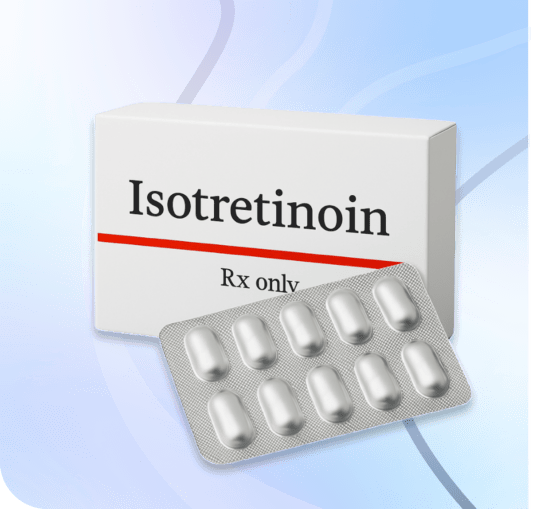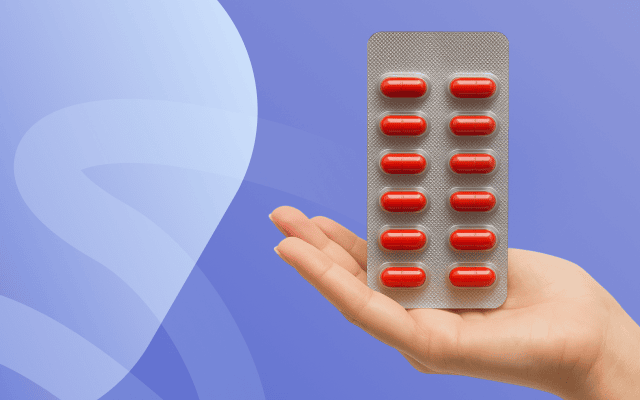Can you avoid the Accutane purge?
Dr. Eric Howell, dermatologist, talks about the Accutane purge and tells you how to reduce its symptoms.
Table of Content:
What is the Accutane purge? | What causes it? | Does it affect everyone? | What to expect? | Can you avoid it? | How to minimize symptoms? | Accutane purge timeline | How to plan for it?
Our commitment to producing high-quality content:
The information presented in this article is based on scientific research and the professional advice of our Content Medical Reviewers, who are experts in the field of Dermatology. How we write our content →
What is the Accutane (isotretinoin) purge?
Dr. Eric Howell, board-certified dermatologist, says that the Accutane (isotretinoin) purge is a temporary worsening of acne that some people experience shortly after starting Accutane (isotretinoin) treatment. It can be frustrating —especially since Accutane is meant to clear acne— not worsen it. However it’s usually a short-lived phase in the treatment process which also means the treatment is working.
What causes the Accutane (isotretinoin) purge?
Dr. Howell says that the Accutane purge is caused by the effects Accutane has on the skin, leading to temporary changes that may worsen acne before improving it.
Here’s what causes it:
- Deep exfoliation: Accutane speeds up skin cell turnover, which means it brings existing clogs, oil, and impurities to the surface more quickly than usual.
- Sebum suppression: It drastically reduces the amount of oil (sebum) your skin produces. At first, this sudden change can throw your skin off balance, making existing acne worse before it gets better.
- Inflammation response: Accutane can initially irritate the skin, triggering inflammation that might cause acne to look more red and swollen.
*Patients who qualify may request a generic version of isotretinoin, which is much more affordable and equally effective.
Does everyone purge on Accutane (isotretinoin)?
Dr. Howell says that while an initial worsening of acne is a known side effect of isotretinoin, it does not occur in all patients. Studies indicate that up to 32% of patients experience an initial acne flare during the first month of isotretinoin treatment. The severity of these flares varies, with most being mild to moderate1.
Studies show that factors such as age, gender, acne severity, and treatment dosage can influence the likelihood and severity of a purge2 3.
What can you expect while going through the Accutane (isotretinoin) purge?
If you do experience a purge, here’s what it might look and feel like:
- Worsening acne: You may notice more breakouts, often deeper and more inflamed than usual, especially in the first few weeks.
- Dryness and peeling: Accutane reduces oil production, which can lead to dry, flaky skin—even in places you’ve never had issues.
- Redness and irritation: Your skin may feel sensitive, tight, or look red and inflamed.
- Breakouts in new areas: Some people get acne in places they haven’t before (like their neck or chest).
- Emotional impact: The purge can be discouraging, especially when you were hoping for improvement. It’s normal to feel a bit anxious or frustrated during this phase.
Can you avoid the Accutane (isotretinoin) purge?
Dr. Howell says that while you can’t avoid the Accutane purge completely, there are some steps you can take to reduce the risk or make it milder. Starting with a low dose is one of the most effective ways, especially for people with severe or cystic acne.
In addition to that, Dr. Howell says he sometimes also prescribes oral antibiotics or topical treatments to calm the skin before beginning Accutane.
How to minimize the Accutane (isotretinoin) purge?
Dr. Howell says that if you are already going through the purge, these tips can help minimize discomfort and support your skin:
Start with Accutane (isotretinoin) with a low dose
Dr. Howell explains that starting Accutane (isotretinoin) with a low dose allows your body and skin to adapt more gradually to the powerful medication. This approach significantly reduces the risk of a sudden acne flare—commonly known as the purge—and can also lessen common side effects like dryness, irritation, and inflammation. Gradually increasing the dose over time helps the skin build tolerance and makes the treatment process more manageable. He says he often tailors the starting dose based on the patient’s weight and acne severity, so it’s important to discuss a personalized plan before starting treatment.
Take an antihistamine with isotretinoin
Dr. Howell says that research shows that using an over-the- counter antihistamine (such as Claritin, Zyrtec, Allegra or Benadryl) can be safely used alongside Accutane to help reduce inflammation and allergic-type reactions like itching or redness. Clinical studies have shown that this combination can reduce itching by 30% and acne breakouts by 40% compared to Accutane alone. Antihistamines work by calming the body’s histamine response, which can help relieve dryness, irritation, and other symptoms that commonly appear during the purge phase4 5.
Ask your dermatologist about prescribing an oral steroids (like Prednisone) in case of severe flare-ups
For patients experiencing severe flare-ups—especially painful, inflamed, or cystic breakouts—Dr. Howell has sometimes prescribed a short course of oral corticosteroids like prednisone. These medications are anti-inflammatory and help quickly calm down intense immune responses triggered by isotretinoin. This is typically a temporary solution to get the acne under control while continuing Accutane6 7.
Dr. Howell emphasizes that steroids should only be used under close medical supervision, as they can have significant side effects if misused or taken for more than a month or two.
Maintain a gentle skincare routine
Dr. Howell emphasizes the importance of being kind to your skin during Accutane treatment. Avoid products containing active ingredients like retinoids, benzoyl peroxide, or salicylic acid unless specifically directed by your dermatologist. Instead, stick to a non-foaming, fragrance-free cleanser, a rich, hydrating moisturizer, and broad-spectrum, sunscreen SPF 50. Keeping your skin barrier strong and protected helps reduce sensitivity and flaking, especially during the purge.
Use non-comedogenic products
Everything that touches your skin—cleanser, moisturizer, sunscreen, makeup—should be labeled “non-comedogenic”, meaning it won’t clog pores. During the purge, your skin is already prone to breakouts, so it’s essential to avoid anything that could make it worse. Oil-free and lightweight formulas are typically best. Dr. Howell recommends looking for minimal-ingredient products to reduce the risk of irritation or allergic reactions.
Avoid picking or squeezing blemishes
It might be tempting, especially during the purge, but picking at your skin can make inflammation worse, push bacteria deeper, and increase your chances of permanent scarring. Dr. Howell advises letting breakouts run their course naturally. If you’re struggling with the urge to pick, using hydrocolloid patches can help break the habit. Trust the process—your skin is healing even if it doesn’t look like it yet.
*Patients who qualify may request a generic version of isotretinoin, which is much more affordable and equally effective.
How long does the Accutane (isotretinoin) purge last?
Dr. Howell says that the Accutane purge usually lasts 2 to 6 weeks, but it can vary. For some, it may be over in a couple of weeks; for others, it can stretch into the second month. It’s important to remember this phase is temporary and typically followed by noticeable skin improvement.
Accutane (isotretinoin) purge timeline
Week 1–2: You notice the first early reactions towards Accutane (isotretinoin)
This is when the purge first begins, though not everyone experiences it this early. The medication starts to work under the skin’s surface by:
- Speeding up skin cell turnover, which pushes oil, bacteria, and clogged debris to the surface faster.
- Reducing oil production, which may suddenly leave your skin feeling dry, tight, or flaky, especially around the mouth, nose, and eyes.
- Increasing inflammation temporarily, which can make breakouts appear more red and angry-looking.
- You may also experience other side effects like chapped lips, dry eyes, skin and nose, as well as sun sensitivity.
Dermatologist’s Tip: Use a thick moisturizer and avoid exfoliants.
Week 3–4: The peak of the Accutane (isotretinoin) purge
If you’re going to purge, Dr. Howell says this is when it’s likely to be at its worst:
- Deeper breakouts, especially if you’re prone to cystic acne.
- New pimples appear, often in areas where you already had active acne.
- More redness and skin inflammation than before.
- The dryness and irritation may intensify, making it uncomfortable to wear makeup or shave.
Dermatologist’s Tip: Use an over the counter antihistamine to minimize your symptoms and consult your dermatologist to get a temporary prescription for an oral steroid if your skin flares severely.
Week 5–6: The Turning Point
For many, this is when they start seeing an improvement in their acne.
- Less new breakouts
- Older acne lesions start to heal and flatten out.
- Inflammation typically begins to reduce.
- Overall irritation starts to calm.
Dermatologist’s Tip: Continue sun protection, hydration, and gentle skincare.
After Week 6: Visible improvements begin
By this point, many people see noticeable improvement:
- Breakouts become much less frequent or stop altogether.
- The skin begins to look smoother, less congested, and more even in tone.
- Red marks from older acne may still be visible (called post-inflammatory erythema or hyperpigmentation), but active acne is significantly reduced.
- Side effects may persist (like dryness), but they tend to be more manageable.
Dermatologist’s Tip: Continue sun protection, hydration, and gentle skincare.
How to plan for the Accutane (isotretinoin) purge?
Dr. Howell says that preparing for the Accutane purge can make a big difference in how you feel physically and emotionally during treatment. Here’s a detailed checklist to help you feel ready and supported from day one:
- Start treatment during a low-stress period
If possible, begin Accutane when your schedule is calm—like during school breaks, work downtime, or after major life events. This gives you space to be alone if you need to without added pressure. - Talk to your dermatologist about a low-dose start
Starting with a low dose can help reduce the severity of the purge and side effects. Your dermatologist can gradually increase the dose as your skin adapts. - Prep your skin
Stop using any harsh ingredients (like retinoids, AHAs, or BHAs) a week or two before starting. Stick to a gentle cleanser, barrier-repair moisturizer, and SPF 50+. - Stock up on hydrating essentials
Accutane dries out more than just your skin—lips, eyes, nose, and joints too. You’ll want:- Thick lip balm (Aquaphor, CeraVe Healing Ointment)
- Fragrance-free facial moisturizer
- Gentle body lotion
- Artificial tears or eye drops
- Nasal saline spray (for dry nose or nosebleeds)
- Buy a humidifier (especially in dry climates or winter months)
- Buy OTC antihistamines
Taking non-drowsy antihistamines like Claritin, Zyrtec, or Allegra can help reduce inflammation, itching, and purge-related flare-ups. Talk to your dermatologist before starting. - Wash your pillowcase and towel more often
Change pillowcases every few days and use a clean towel every day to avoid bacteria buildup. - Mentally prepare
Knowing that the purge is normal and temporary can reduce anxiety. Read success stories, join support forums, or keep a journal to stay grounded and hopeful. - Keep track your skin’s progress
Use the Miiskin app to take weekly photos to monitor changes in your skin. Even when your skin feels worse, the photos can help you see subtle improvements and keep you motivated. - Communicate with your dermatologist
If you choose a dermatologist via Miiskin, you can use the messaging functionality available in the app to ask questions about your symptoms or treatment to your dermatologist. Let them know about any side effects, even mild ones. They can adjust your dose, recommend additional treatments, or reassure you through tough phases.
Accutane treatment
Read more Accutane articles reviewed by board-certified dermatologists
Patient Guide: Everything you need to know about Accutane
Low-dose Accutane, is this right for you?
Article References:
https://pmc.ncbi.nlm.nih.gov/articles/PMC2835909/
https://www.researchgate.net/publication/5282140_Predictive_factors_for_acne_flare_during_isotretinoin_treatment
https://pubmed.ncbi.nlm.nih.gov/18573721/
https://pubmed.ncbi.nlm.nih.gov/25081735/
https://www.sciencedirect.com/science/article/pii/S2950198924000308
https://www.medicaljournals.se/acta/content/html/10.2340/00015555-1325





 Do you want a prescription for isotretinoin?
Do you want a prescription for isotretinoin?
